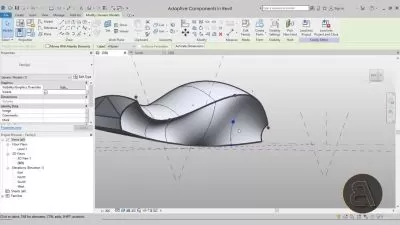Revit Made Easy: Complete Course for Architects & Designers
5:51:33
Description
Your All-in-One Guide to Revit for Architecture and Design
What You'll Learn?
- Fundamentals of Autodesk Revit: Understand the Revit interface, basic tools, and key concepts.
- Creating Architectural Models: Learn how to model walls, doors, windows, roofs, and other architectural elements.
- Documentation and Schedules: Create construction documentation, such as sections, elevations, and material schedules.
- Detailed Floor Plans and Layouts: Design floor plans, add dimensions, annotations, and room tags for detailed layouts.
- 3D Modeling and Visualization: Master 3D views, rendering techniques, and presentation-ready visuals.
- Families and Components: Understand how to use and customize Revit families to enhance design flexibility
- Discover shortcuts, best practices, and workflow tips for efficient Revit use
Who is this for?
What You Need to Know?
More details
DescriptionThis Revit Made Easy course offers a complete, in-depth guide for architects, designers, and anyone new to Revit who wants to build a solid foundation and advance to professional-level skills. Starting with the basics, you’ll learn how to navigate Revit’s interface and set up projects efficiently. From there, you’ll progress through the essentials of creating architectural elements like walls, doors, windows, and roofs, and learn to use Revit’s powerful tools to shape spaces, design layouts, and manage details with precision.
As the course advances, you’ll dive into Building Information Modeling (BIM) principles, understanding how Revit enables you to manage data-rich models that enhance coordination, accuracy, and collaboration across projects. You’ll explore the creation of detailed floor plans, sections, elevations, and 3D views, mastering techniques to produce construction documents that communicate design intent effectively. Additionally, you’ll work with structural elements, customize Revit families, and learn to leverage the software’s robust annotation and scheduling features to document and manage projects seamlessly.
By the end of the course, you’ll not only be equipped with the knowledge to use Revit confidently but also complete a portfolio-ready project showcasing your ability to create, document, and present professional architectural designs. This course is perfect for architecture students, design professionals, and career switchers who are ready to elevate their design skills and embrace Revit for more efficient, precise, and collaborative project workflows.
Who this course is for:
- Beginners in Revit: Those new to Revit who want a comprehensive, step-by-step guide
- Architecture and Design Students: Students studying architecture, interior design, or related fields who want to gain practical Revit skills.
- Architects and Designers: Professionals looking to add Revit to their skill set for architectural modeling and BIM
- Engineers and Construction Professionals: Engineers, drafters, and construction managers interested in learning Revit for better collaboration and project management
- BIM Enthusiasts: Anyone interested in understanding Building Information Modeling (BIM) and how Revit applies it to streamline design and construction processes
- Career Switchers: Individuals looking to transition into architecture, design, or BIM roles who need foundational skills in Revit
This Revit Made Easy course offers a complete, in-depth guide for architects, designers, and anyone new to Revit who wants to build a solid foundation and advance to professional-level skills. Starting with the basics, you’ll learn how to navigate Revit’s interface and set up projects efficiently. From there, you’ll progress through the essentials of creating architectural elements like walls, doors, windows, and roofs, and learn to use Revit’s powerful tools to shape spaces, design layouts, and manage details with precision.
As the course advances, you’ll dive into Building Information Modeling (BIM) principles, understanding how Revit enables you to manage data-rich models that enhance coordination, accuracy, and collaboration across projects. You’ll explore the creation of detailed floor plans, sections, elevations, and 3D views, mastering techniques to produce construction documents that communicate design intent effectively. Additionally, you’ll work with structural elements, customize Revit families, and learn to leverage the software’s robust annotation and scheduling features to document and manage projects seamlessly.
By the end of the course, you’ll not only be equipped with the knowledge to use Revit confidently but also complete a portfolio-ready project showcasing your ability to create, document, and present professional architectural designs. This course is perfect for architecture students, design professionals, and career switchers who are ready to elevate their design skills and embrace Revit for more efficient, precise, and collaborative project workflows.
Who this course is for:
- Beginners in Revit: Those new to Revit who want a comprehensive, step-by-step guide
- Architecture and Design Students: Students studying architecture, interior design, or related fields who want to gain practical Revit skills.
- Architects and Designers: Professionals looking to add Revit to their skill set for architectural modeling and BIM
- Engineers and Construction Professionals: Engineers, drafters, and construction managers interested in learning Revit for better collaboration and project management
- BIM Enthusiasts: Anyone interested in understanding Building Information Modeling (BIM) and how Revit applies it to streamline design and construction processes
- Career Switchers: Individuals looking to transition into architecture, design, or BIM roles who need foundational skills in Revit
User Reviews
Rating

Udemy
View courses Udemy- language english
- Training sessions 20
- duration 5:51:33
- Release Date 2025/02/27









